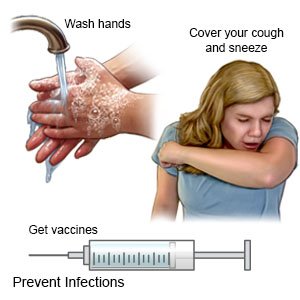Droplet Precautions
Medically reviewed by Drugs.com. Last updated on Sep 23, 2025.
AMBULATORY CARE:
Droplet precautions
prevent the spread of germs that cause respiratory viruses such as influenza (flu), pertussis, and pneumonia. The germs are spread when an infected person talks, coughs, or sneezes. Other people can become infected by breathing in the germs or getting the germs in their eyes.
Related medications
Droplet precautions at home:
When you are able to go home, you must continue to take your medicines as directed. You may be directed to use the precautions you used in the hospital, in addition to the following:
- Each person will put on a mask as he or she comes into your room and wash his or her hands before leaving.
- You will need to put on a mask if you have to leave your room. Do not to get too close to others. Germs can spread up to 3 feet away from you.
- Cover your mouth and nose with a tissue when you cough or sneeze. Use a tissue that covers your mouth and nose. Throw the tissue away in a trash can right away. Use the bend of your arm if a tissue is not available. Wash your hands well with soap and water or use a hand sanitizer.
- Wash your hands often. Remind others around you to wash often. Rub your soapy hands together, lacing your fingers. Wash the front and back of your hands, and in between your fingers. Use the fingers of one hand to scrub under the fingernails of the other hand. Wash for at least 20 seconds. Rinse with warm, running water for several seconds. Then dry your hands with a clean towel or paper towel. Use hand sanitizer that contains alcohol if soap and water are not available. Do not touch your eyes, nose, or mouth without washing your hands first.

- Surfaces need to be cleaned often. You or someone caring for you should clean doorknobs, countertops, cell phones, and other surfaces that are touched often. Use a disinfecting wipe, a single-use sponge, or a cloth you can wash and reuse. Use disinfecting cleaners if you do not have wipes. You can create a disinfecting cleaner by mixing 1 part bleach with 10 parts water.
 |
© Copyright Merative 2025 Information is for End User's use only and may not be sold, redistributed or otherwise used for commercial purposes.
The above information is an educational aid only. It is not intended as medical advice for individual conditions or treatments. Talk to your doctor, nurse or pharmacist before following any medical regimen to see if it is safe and effective for you.
Learn more about Droplet Precautions
Care guides
Further information
Always consult your healthcare provider to ensure the information displayed on this page applies to your personal circumstances.
